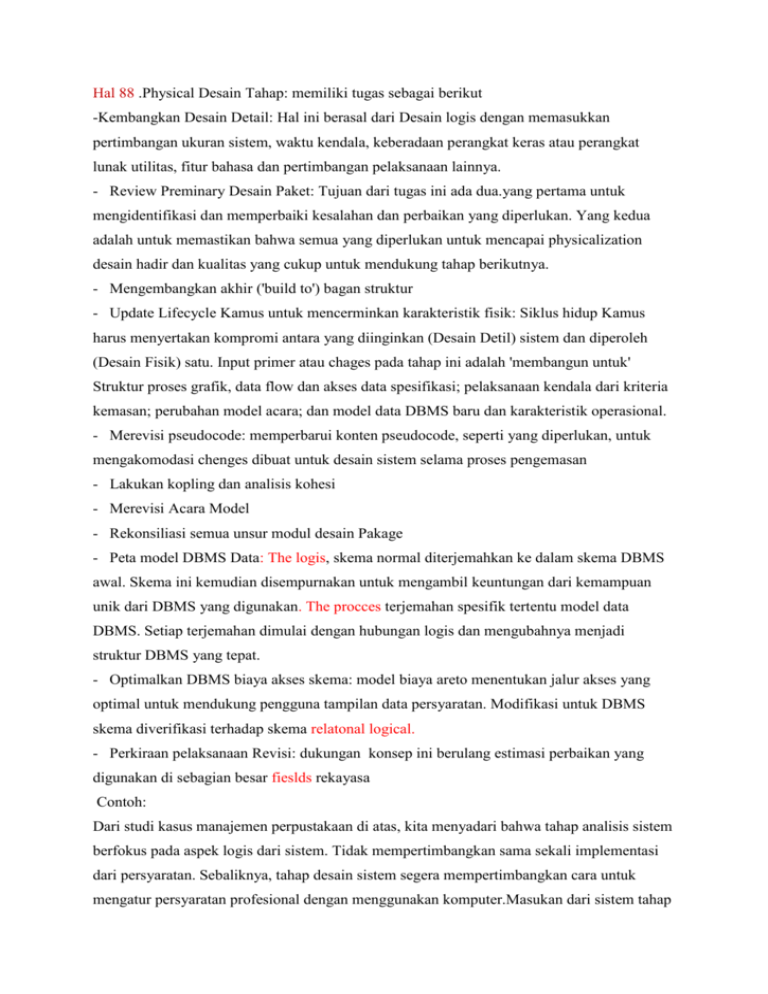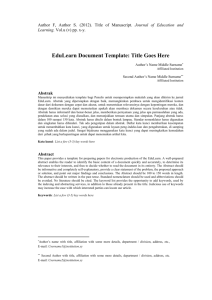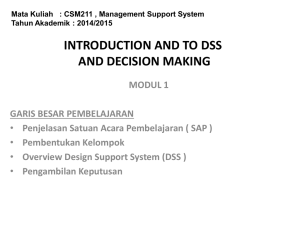laporan perancangan sistem
advertisement

Hal 88 .Physical Desain Tahap: memiliki tugas sebagai berikut
-Kembangkan Desain Detail: Hal ini berasal dari Desain logis dengan memasukkan
pertimbangan ukuran sistem, waktu kendala, keberadaan perangkat keras atau perangkat
lunak utilitas, fitur bahasa dan pertimbangan pelaksanaan lainnya.
- Review Preminary Desain Paket: Tujuan dari tugas ini ada dua.yang pertama untuk
mengidentifikasi dan memperbaiki kesalahan dan perbaikan yang diperlukan. Yang kedua
adalah untuk memastikan bahwa semua yang diperlukan untuk mencapai physicalization
desain hadir dan kualitas yang cukup untuk mendukung tahap berikutnya.
- Mengembangkan akhir ('build to') bagan struktur
- Update Lifecycle Kamus untuk mencerminkan karakteristik fisik: Siklus hidup Kamus
harus menyertakan kompromi antara yang diinginkan (Desain Detil) sistem dan diperoleh
(Desain Fisik) satu. Input primer atau chages pada tahap ini adalah 'membangun untuk'
Struktur proses grafik, data flow dan akses data spesifikasi; pelaksanaan kendala dari kriteria
kemasan; perubahan model acara; dan model data DBMS baru dan karakteristik operasional.
- Merevisi pseudocode: memperbarui konten pseudocode, seperti yang diperlukan, untuk
mengakomodasi chenges dibuat untuk desain sistem selama proses pengemasan
- Lakukan kopling dan analisis kohesi
- Merevisi Acara Model
- Rekonsiliasi semua unsur modul desain Pakage
- Peta model DBMS Data: The logis, skema normal diterjemahkan ke dalam skema DBMS
awal. Skema ini kemudian disempurnakan untuk mengambil keuntungan dari kemampuan
unik dari DBMS yang digunakan. The procces terjemahan spesifik tertentu model data
DBMS. Setiap terjemahan dimulai dengan hubungan logis dan mengubahnya menjadi
struktur DBMS yang tepat.
- Optimalkan DBMS biaya akses skema: model biaya areto menentukan jalur akses yang
optimal untuk mendukung pengguna tampilan data persyaratan. Modifikasi untuk DBMS
skema diverifikasi terhadap skema relatonal logical.
- Perkiraan pelaksanaan Revisi: dukungan konsep ini berulang estimasi perbaikan yang
digunakan di sebagian besar fieslds rekayasa
Contoh:
Dari studi kasus manajemen perpustakaan di atas, kita menyadari bahwa tahap analisis sistem
berfokus pada aspek logis dari sistem. Tidak mempertimbangkan sama sekali implementasi
dari persyaratan. Sebaliknya, tahap desain sistem segera mempertimbangkan cara untuk
mengatur persyaratan profesional dengan menggunakan komputer.Masukan dari sistem tahap
desain Apakah spesifik. Persyaratan yang dibangun pada tahap analisis sistem, termasuk:
-Funcation Hierarchy Diagram
- Data Flow Diagram
- Entity Relationship Diagram
- Pada tahap perancangan sistem, kita harus:
1. Menentukan fungsi harus dilakukan oleh manusia, dan yang berfungsi harus dilakukan
oleh komputer, sehingga kita memiliki sistem DFD (setengah-fisik)
Database 2. desain
3. merancang manusia / interface komputer
Berbeda dengan tahap analisis sistem yang membutuhkan beberapa alat dan teknik, terutama
untuk struktur bangunan, dalam tahap desain, memilih menggunakan alat sangat flaxible.
Beberapa alat yang digunakan secara rinci dan cermat. Beberapa alat lain yang digunakan
lebih fleksibel, dan beberapa mungkin tidak pernah digunakan. Hal ini tergantung pada
kebutuhan pengalaman perancang sistem.
Sedikit pun sistem manajemen perpustakaan tahap desain sistem berkonsentrasi pada tahap
utama berikut: untuk menentukan sistem komputer, untuk merancang modul dan merancang
database.
Hal 89. 3.2.2 identifikasi sistem komputer
Ini adalah tahap pertama dalam desain sistem dan harus menentukan bagian mana dari sistem
harus ditangani oleh komputer dan bagian mana oleh pengguna. Pada fase ini, bisnis DFD
akan digunakan di kedua deskripsi persyaratan dan proses lainnya pada tingkat terendah dan
mempertimbangkan peran komputer dalam setiap proses. Melihat bisnis DFD sebagai model
logis penting untuk sistem, sistem DFD dapat lebih baik digambarkan sebagai "setengahfisik". Hal ini karena meskipun telah membentuk proses yang akan ditangani oleh komputer,
belum menyatakan bagaimana cara untuk menerapkannya, penciptaan dan penggunaan
program dan file data. Pada dasarnya, proses dari sistem DFD dibangun atas dasar proses
logis dari bisnis yang relevan DFD. Bahkan, jika salah satu proses bisnis ditransfer ke fase
merancang atau sebagai tugas komputerisasi atau non-komputerisasi, itu masih bernama sama
di kedua DFD bisnis dan sistem model DFD. Dalam kasus proses logis dirancang untuk
sebagian terkomputerisasi dan sebagian dilaksanakan secara manual, diperlukan bahwa setiap
proses baru dalam sistem DFD harus ditelusuri dalam proses bisnis DFD dan bagaimana cara
kita untuk membuatnya terpisah.
hal 90-91 .Menentukan sistem komputer dalam contoh yang disajikan:
Ini adalah tahap pertama dalam tahap desain sistem. Tergantung pada bisnis DFD dalam
tahap analisis sistem, kita membangun sistem DFD untuk menentukan fungsi yang harus
dilakukan oleh komputer dan yang berfungsi untuk dilakukan oleh manusia:
Dalam hal ini fungsi manajemen pembaca, kita menyadari bahwa ketika staf ingin menjadi
pembaca, dia (atau dia) harus mendaftar dengan pustakawan, sehingga menerima pembaca
sub_function baru harus dilakukan oleh pustakawan. Ini sub_functions lainnya akan
dilakukan oleh komputer.
Dalam fungsi manajemen dokumen, kita menyadari bahwa dokumen baru harus diterima dan
diklasifikasikan oleh pustakawan. Setelah itu, pustakawan akan menggunakan komputer
untuk memasukkan informasi dokumen yang baru saja diklasifikasikan sebagai buku atau
majalah. Oleh karena itu, kita memiliki diagram di atas.
Hal 92. Dalam peminjaman / memberikan kembali dokumen fungsi manajemen tiket, kita
menyadari bahwa ada dua sub_function: Menerima Pinjaman / memberikan kembali tiket dan
memutar untuk pembaca harus dilakukan oleh pustakawan, komputer hanya mengambil
sub_function: memeriksa informasi masukan tentang tiket ini apakah benar atau tidak dan
mengembalikan hasil kepada pustakawan di komputer screen.seperti yang ada pada diagram
di atas.
Fungsi yang kedua yaitu: Looking up documents dan pelaporan harus dilakukan oleh
komputer karena kebenarannya bahwa dokumen pengolahan disimpan dalam komputer
sekarang.
3.2.3 Model kontruksi
Membangun aliran data sistem berarti menguraikan ide-ide sistem desainer tentang
bagaimana komputer harus digunakan dalam sistem di future.DFD, yang membantu analisis
dan desain proses, membantu desainer memodelkan idenya quickly.berdasarkan itu, diskusi
antara sistem pengembang diadakan untuk menyempurnakan model.
88.Physical Design Phase:has tasks as followings
-Develop Detail Design:It is derived from the logical Design by incorporating consideration of system
size,timing constraint,the existence of hardware or software utilities,language features and other
implementation considerations.
-Review Preminary Design Package:The purpose of this task is twofold.One is to identify and correct
errors and necessary refinements. The other is to ensure that all that is necessary to accomplish the
physicalization of the design is present and of sufficient quality to support this next phase.
- Develop final (‘build to’) structure chart
- Update Lifecycle Dictionary to reflect physical characteristics: The lifecycle Dictionary must include
the compromises between the desired ( Detail Design ) system and the obtainable ( Physical Design )
one. The primary inputs or chages at this stage are the ‘build to’ Structure chart process, dataflow
and data access specifications; the implementation constrains from the packaging criteria; the
changes to the event model; and the new DBMS data model and its operational characteristics.
- Revise pseudocode: update the content of the pseudocode, as necessary, in order to accommodate
the changes made to the system design during the packaging process
- Perform coupling and cohesion analysis
- Revise Event Model
- Reconcile all element of modul design pakage
- Map to DBMS Data model: The logical, normalized schema is translated into an initial DBMS
schema. This schema is then refined to take advantage of the unique capabilities of the DBMS being
used. The translation process is specific of the particular DBMS data model. Each translation starts
with a logical relation and converts it into an appropriate DBMS structure.
- Optimize DBMS schema access costs: cost model areto determine optimal access paths to support
the user data view requirements. Any modifications to the DBMS schema are verified against the
logical relaional schema.
- Revise implementation estimates: this support the concepts of iterative estimation refinement that
is used in most engineering fields
Example:
From the above library management case study, we realize that the system analysis stage focuses on
the logical aspect of the system. It does not consider at all the implementations of the requirements.
By contrast, the system design phase immediately considers the ways to set up the professional
requirements by using computer.
The inputs of system design phase Are the specific. Requirements which were built in the system
analysis phase, including:
-Function Hierarchy Diagram
- Data Flow Diagram
- Entity Relationship Diagram
- In the system design phase, we have to:
1. Define which functions have to be done by human, and which functions have to be carried out by
computer, so we have DFD system (half-physical )
2. design database
3. design the human/computer interface
Unlike the system analysis phase which needs a few tools and technique, mainly for structure
building, in the design phase, the choose of using a tool is very flexible. Some tools are used in
detail and closely. Some other are used more flexible, and some may never be used. It depends on
the requirement of the experience of the system designer.
Whit the library management system the system design phase concentrates on the following main
parts: to determine the computer system, to design modules and to design the database.
89-90. 3.2.2 identification of the computer system
This is the first phase in system design and it should define which part of the system should
be handled by computers and which part by users. In this phase, business DFD will be used in both
requirement description and in other processes at the lowest level and consider the role of
computer in each process. Looking at business DFD as a logical model essential to the system,
system DFD can be better described as “half-physical”. This is because although it has formed the
processes to be handled by computer, it hasn’t expressed the way to implement them, the creation
and usage of program and data files. Basically, the processes of the system DFD are built on the
basis of logical processes of relevant business DFD. In fact, if one of the business processes is
transferred to the designing phase or as a computerised or non-computerised task, it is still named
the same in both business DFD and system DFD models. In case of a logical process is designed to be
partially computerised and partially manually implemented, it is required that any new processes in
the system DFD must be traced in the processes of the business DFD from which we will make the
apart later.
Determines the computer system in the presented example: This is the first stage in the system
design phase. Depend on the DFD business in the system analysis phase, we build the DFD system to
determine which functions to be carried out by computer and which functions to be done by human:
In this reader management function, we realize that when a staff wants to be a reader, he (or she)
has to register with the librarian, so the received new reader sub_function has to be done by the
librarian. These other sub_functions will be done by computer.
In the document management function, we realize that new documents must be received and
classified by the librarian. After that, the librarian will use computer to input information of
document which have just been classified as books or magazines. Therefore, we have the above
diagram.
Hal 91-92. In the lending/giving back document ticket management function,we realize that there
are two sub_function:Receiving Lending/Giving back ticket and replaying to readers must be done
by the librarian,the computer only takes on sub_function:checking the input information about
these ticket whether correct or not and returns the result for librarian on the computer screen.so
we have the the above diagram.
The two remaining function namely:Looking up document and reporting have to be carried out by
the computer,becouse in fact that the processing documents are stored in computer now.
3.2.3
Constructing the system data flow means outlining the system designer’s ideas on how computers
should be should be used in the system in the future.DFD,which assists the analysis and design
process,helps designer modelize his idea quickly.On that basis,discussion among system developers
are held to fine-tune the model.





